
Freddie McKnight
Freddie McKnight is an accomplished predator hunter and author from central Pennsylvania.
Switching from Fur to Feathers
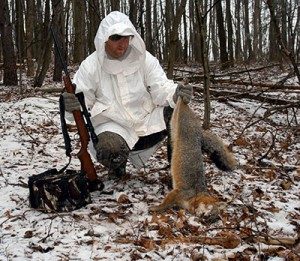 The conditions are perfect for a day of predator hunting. A light layer of snow covers the ground. Barely a wisp of air is moving through the forest. Tracks in the snow indicate that predators have been active in the immediate area, and the first stand of the morning produces a grey fox bounding to the call. Since that time, however, nothing has stirred and you wonder what you are doing wrong.
The conditions are perfect for a day of predator hunting. A light layer of snow covers the ground. Barely a wisp of air is moving through the forest. Tracks in the snow indicate that predators have been active in the immediate area, and the first stand of the morning produces a grey fox bounding to the call. Since that time, however, nothing has stirred and you wonder what you are doing wrong.
Unfortunately this scenario is repeating itself more and more each year. In the past couple of decades, an untold number of predator hunters have joined the ranks. Filled with ambition fueled by expanding coyote numbers, these hunters are helping to educate an already wary opponent. In addition, dozens of organized predator hunts take place each year which puts even more hunting pressure on these animals. While most of these hunts have a statewide boundary, some are regulated to specific counties which can funnel pressure into a specific area. At least for the immediate future, hunting any kind of fur via the predator call is going to be even more challenging.
Fortunately, days without action can quickly be turned around – thanks to another predator, the American crow. These birds are numerous across the state and can provide hours of action packed thrills. Crow hunting used to have quite a following, but that has waned now that the coyote is so well established.
Regulated as a migratory bird by the U.S. Fish and Wildlife Service, crows cannot be hunted seven days a week. In Pennsylvania, regulations limit crow hunting to Fridays, Saturdays and Sundays. Crow season runs from July to early spring, with a late March or early April closing date that varies each year. Make sure you know the regulations about the seasons and firearms for these birds before you go on your next predator outing.
Switching from chasing furred predators to those on the wing is simple, as most of the necessary items can be carried in a vest or backpack. Since you may burn through a lot of ammo, try using low brass shotgun shells. The size shot you choose is a personal choice, but regardless of what you use make sure to test it through your gun. You might find that you will need to switch chokes to provide the best results.
A couple of decoys can also be added to your gear with minimal weight. While crow decoys will be obvious to use, don’t overlook an option such as a rabbit. Crows are predators and have been known to gang up to kill injured mammals of smaller size at times. They have learned that other predators that kill such animals may leave behind scraps, which the crows can quickly swoop in to take for their meal. I believe that is why you see these birds coming to investigate the animal in distress sounds when you are hunting furred predators. These calls are a great change up to the crow sounds, which may not work on the birds if crow hunting is popular in your area.
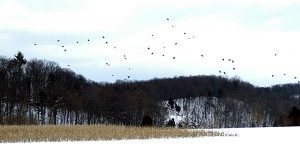 While crows are not hard to kill, they can be hard to get within gun range. Equipped with some of the best eyesight in nature, they will flare off from your setup at the first hint of danger. For this reason, you and your equipment must blend into your surroundings. A face mask, gloves and anti-glaring of some sort on your gun are a must. Decoys help to lure the crows in, especially any that where you can add motion. A simple piece of fishing line strung over a branch will help your efforts. Just attach it to the decoy and launch it when the first birds appear overhead. Seeing another of their kind flying below will ease their suspicious nature and lure them into range of your shotgun.
While crows are not hard to kill, they can be hard to get within gun range. Equipped with some of the best eyesight in nature, they will flare off from your setup at the first hint of danger. For this reason, you and your equipment must blend into your surroundings. A face mask, gloves and anti-glaring of some sort on your gun are a must. Decoys help to lure the crows in, especially any that where you can add motion. A simple piece of fishing line strung over a branch will help your efforts. Just attach it to the decoy and launch it when the first birds appear overhead. Seeing another of their kind flying below will ease their suspicious nature and lure them into range of your shotgun.
You will find that the best set ups for crows are nearly the same as for other predators. Personally, I like to find a spot with a higher vantage point, such as overlooking a valley or at the point of a ridge. This gives me the advantage of long sight distances so I can be prepared for any incoming birds and be in position without moving when they close the distance. My experience has taught me that crows will often circle higher and settle in to tree branches to look things over before committing to anything.
In any crow hunting situation, it is best to settle in away from the call. A distance of 30 or 40 yards is ideal, as the birds will often circle the area to observe the situation below them. This distance should put you in the flight path and in perfect position for shooting the birds while their attention is focused on the calling source. It is no different from hunting predators on the ground, except your targets now are much more visible given the fact that they have nothing to hide behind in the sky.
Unlike ground-based predator hunting, you may be able to sit on the same stand for hours and have birds respond. Crows will travel around their core areas, using different portions of it during different times of the day. This means that you may catch the attention of different birds.
Try another tactic to entice more crows to your call by pausing your calling for 15 to 20 minutes at a time. After you shoot at a few crows, you will often hear other birds off in the distance that have grown weary of the shooting and refuse to come within range. Their vocalizations will often attract the attention of other birds, ones that are too far away to hear your calling. Pausing the call will allow things to settle down and then you can start again to attract the attention of a fresh group of birds for a repeat scenario.
Crow hunting is a great alternative when you are craving action and furred predators are not cooperating. Not only will you get some trigger time, but you will also be doing a type of community service. Sometimes crows gather in such large numbers that they pose a health concern because of all of their droppings. This species is also prone to carry diseases, such as avian bird flu and west Nile virus. One final factor is that this species is responsible for an untold amount of crop damage, eating those that are ripe as well as digging up seeds in freshly plowed farm fields and gardens across the state. So next time your furred predator hunt leaves you disappointed, why not switch to a winged predator to keep the action coming.
Preparations for Wade Fishing
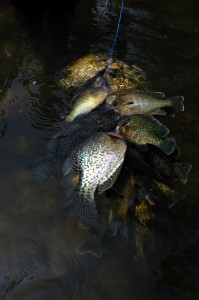 Summertime and wade fishing go together like peanut butter and jelly. Once the warm weather hits the area, there is no better way to enjoy a relaxing outing than getting wet with the fish. Look at it this way, even if the fish are not biting, you can take a relaxing dip in the water to cool down.
Summertime and wade fishing go together like peanut butter and jelly. Once the warm weather hits the area, there is no better way to enjoy a relaxing outing than getting wet with the fish. Look at it this way, even if the fish are not biting, you can take a relaxing dip in the water to cool down.
Before you head out though, there are some decisions to make that can determine the outcome of your trip. The first decision is what to wear. Past experience may help you decide your attire, but generally those who wade fish are about 50/50 on using waders or shorts and shoes.
The decision is a personal one, but you must take into account what kind of stream you are fishing. If the water is clear and devoid of snags, I prefer to go with shorts and an old pair of sneakers. If the stream bottom is mud and there are possibilities of rubbing against downed trees, then I go with waders.
During the hot weather, waders can be a bother as they tend to make you sweat. This is especially true of tight fitting neoprene types that don’t allow air in. Also, the sun shining on the dark material can make you uncomfortable, but the outer coating will protect you from abrasions, bugs, and who knows what in the water. If you are on a trip where you are traveling a distance from your home, you may opt for waders as sitting in wet clothes on a long ride can be uncomfortable.
Regardless of what you choose, be prepared for the inevitable fall. No matter how careful you are, a dunking is going to occur either because of slippery conditions or a stream that did not appear to be that deep. Normally this is not an unwelcome part of the trip, but it can be a dangerous situation if you are wearing chest waders. To help in this situation, a wading staff is a good item to have. Make sure you get one that has a loop on the handle to keep it from getting away from you when you do fall.
Since getting wet is part of the game, you have to have appropriate tackle storage to keep your items dry. There is nothing more discouraging to me than opening a container to find all my hooks and lures rusted from moisture. This just starts the trip out on the wrong foot.
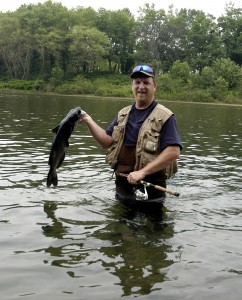 Normally anglers will use a fishing vest or over the shoulder fishing satchel when wading. This allows them to have freedom of movement, but still be able to carry the gear they need to have a good day on the water. There is ample room in both for a few containers to carry your needed lures and terminal tackle, but make sure you buy the brands with water tight seals. Although they tend to be more expensive, they are worth the money.
Normally anglers will use a fishing vest or over the shoulder fishing satchel when wading. This allows them to have freedom of movement, but still be able to carry the gear they need to have a good day on the water. There is ample room in both for a few containers to carry your needed lures and terminal tackle, but make sure you buy the brands with water tight seals. Although they tend to be more expensive, they are worth the money.
Now you are dressed and have your gear selected, so what do you pack in those containers? You will never go wrong by bringing a variety of hooks, split shot and swivels to help meet the needs of the day. In this manner, you can switch from fishing for panfish to targeting carp with a simple change of hook sizes. If you are using a spinning reel, you may also want to consider carrying an extra spool for your reel which will allow you to change up or down in line sizes in order to adapt your gear more in line with the size of the fish you are targeting.
As for lures, go prepared for whatever may swim in the stream you are fishing. You can never go wrong with a jig. Since most anglers who wade fish tend to target panfish and the smaller versions of game fish, small twister tails are a common lure to carry. These same anglers may also encounter much larger species of fish, which means they will probably need to change to a larger sized jig in an attempt to catch it. For that reason, carry a wide selection of jig heads and bodies. I like to have everything from a 1/16 to a 3/4 ounce selection of jig heads. For the bodies, I will carry everything from a one-inch grub to a five- or six-inch minnow-type body on most waters. This will allow you to imitate a variety of food sources for fish of varying sizes.
Another important item that I will not go wade fishing without is a small bait net. It is often difficult to keep live bait alive during the heat of summer and it can be cumbersome to carry around a bait container. If I run into a situation where I can catch live bait, such as crayfish, it is much easier to catch them using the small net. I can also seine the water for insect larvae and minnows in some cases. The bait is fresh and lively, plus it is also something the fish in that particular water are used to seeing. This puts the odds in your favor of the fish taking a bait when they snub their noses at all your other offerings. In addition, you are not transferring unwanted species between waters, which is a big concern in this day and age.
There is one bait that I will always carry along on a summertime wade fishing trip and that is a can of corn. Though the bait is largely thought of for carp, I have taken more than my fair share of bass and panfish with it. Using a smaller hook, one large enough to hold three or four kernels of corn, I will toss the offering upstream and let it float into a location unweighted. It is a great change up bait and one that you don’t see a lot of fishermen using outside of trout season in streams.
One last detail to cover is how to arrange your gear. I like to have the jigs and hooks in the same container, since this is the one I go to most often. I keep the container with these items in a front pocket for quick access so that I can change to meet the conditions with minimal movement. Being in the water with the fish means that they can see you if you can see them and any sudden movements will send them for cover. If you have your gear situated where you can change quickly without much movement, you stand a better chance of success if the fish are in a feeding mood.
Wade fishing can be great fun, and help to pass away the time productively on those hot summer days. Getting the most out of your outing starts with proper planning, knowing what you might encounter on the water and being prepared to meet the conditions to succeed in catching those fish. So sit back, make a list and get out there in the water to have yourself a great time wade fishing.
Tips on Getting Your Gobbler
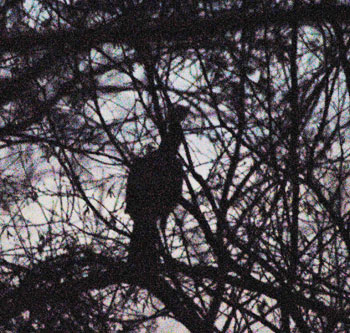 It sounds simple enough: be in the woods at a good listening spot prior to daylight and wait for a gobbler to sound off. Once he does, move to within 100 yards of the bird on roost, call to him and shoot him once he struts your way. Sometimes it is that simple, but if you have hunted turkeys for very long in Pennsylvania, you know that most hunts are much more challenging. To be consistently successful, you need to dig into your bag of tricks. The following are some alternative methods that I have used to take turkeys nearly every year since I started hunting in 1976.
It sounds simple enough: be in the woods at a good listening spot prior to daylight and wait for a gobbler to sound off. Once he does, move to within 100 yards of the bird on roost, call to him and shoot him once he struts your way. Sometimes it is that simple, but if you have hunted turkeys for very long in Pennsylvania, you know that most hunts are much more challenging. To be consistently successful, you need to dig into your bag of tricks. The following are some alternative methods that I have used to take turkeys nearly every year since I started hunting in 1976.
The first objective is to pattern the birds. Public land birds receive a lot of pressure, even before the season begins. They seem to quickly grow quiet, but that does not mean they have left the area. Most of the time their silence is just a reaction to the pressure and they are still living their daily routines in the same location.
Get out before the season starts, at any time of the day, and listen or look for the birds. If they are not vocal, you can always look for their signs. Scratchings in the leaves, tracks in the mud and their droppings are all clues as to where they have been. If you can spot the birds without spooking them, simply sit back and watch in order to learn their habits. You can always find travel routes through their territories, something that will be vital to your success if the turkeys are tight beaked on the day you are hunting.
If you cannot be in the woods, don’t be afraid to use your trail cameras to help you pattern the birds. Perhaps you have found an area where there is turkey sign, but work and daily life don’t allow you to spend hours in the woods. Place your trail cameras throughout the area and let them do the scouting for you. While trail cameras are extremely popular with deer hunters, it is a highly underutilized piece of equipment for turkeys.
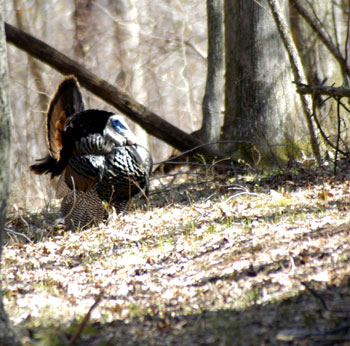 Once the season starts, then you can resort to using other tactics to take your turkey. My most frequently used method is to get as close to the gobbler as possible, whether he is on the roost or on the ground. I ignore the old rule of setting up 100 yards away to call the bird within gun range. I have had far too many hunts ruined by other hunters and deer when doing this. The closer I am in proximity to a turkey, the less distance he has to cover before he is within gun range. There have been many times I have been able to see a bird on roost, yet not taken that turkey. This is hunting and there are no guarantees, but closing the distance has definitely increased my success rate.
Once the season starts, then you can resort to using other tactics to take your turkey. My most frequently used method is to get as close to the gobbler as possible, whether he is on the roost or on the ground. I ignore the old rule of setting up 100 yards away to call the bird within gun range. I have had far too many hunts ruined by other hunters and deer when doing this. The closer I am in proximity to a turkey, the less distance he has to cover before he is within gun range. There have been many times I have been able to see a bird on roost, yet not taken that turkey. This is hunting and there are no guarantees, but closing the distance has definitely increased my success rate.
Calling is a huge part of spring turkey hunting, but the less calling you do, the better. After your first call, the gobbler knows where you are located if he wants to come and check out that sexy hen sound. Aggressive calling, although it will work sometimes, is better left to those doing videos and television slots on one of the hunting channels. Most of those are filmed on private lands, not on Pennsylvania’s public lands.
I combine hunting in close proximity with minimal calling. If you are a turkey hunting veteran, you know that once the birds close the distance between themselves, they resort to clucking and purrs to locate one another. If you are sitting near a bird on roost, this is all you need to do to get his attention, but remember to wait until he has flown down. Many times the hens will fly down first and make their way to the gobbler’s location, which is what nature intends for them to do. If you follow suit with few calls, it will mimic what is naturally going on in the woods at that time and make the gobbler less suspicious of the new hen he has heard.
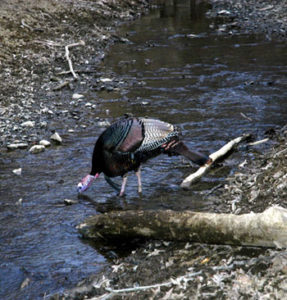 To add more realism to this scenario, don’t be afraid to add other turkey sounds in with the mix. I will often do a fly down imitation by slapping my hat against the side of my leg and then smashing it down in the leaves at the end to simulate a turkey landing. A minute or two later, I may add scratching in the leaves, coupled with some feeding purrs and clucks, to make it seem as though the hen is feeding. Next, I will go completely quiet and wait to see what the gobbler does. This approach has been responsible for harvesting many late season spring gobblers, and some of my biggest birds to boot.
To add more realism to this scenario, don’t be afraid to add other turkey sounds in with the mix. I will often do a fly down imitation by slapping my hat against the side of my leg and then smashing it down in the leaves at the end to simulate a turkey landing. A minute or two later, I may add scratching in the leaves, coupled with some feeding purrs and clucks, to make it seem as though the hen is feeding. Next, I will go completely quiet and wait to see what the gobbler does. This approach has been responsible for harvesting many late season spring gobblers, and some of my biggest birds to boot.
If your early morning hunt does not produce, you can choose to either sit in one of your scouted areas and wait out the turkeys, or run and gun to find a vocal bird. If you do strike up a conversation with a gobbler, remember to not make a direct route to him. Turkeys rarely walk in a straight line towards one another, so you shouldn’t do it either. Instead, zig-zag towards the bird before you set up to lure him in the final distance. When you have an opportunity, make a move towards the gobbler. Even if it is only five or 10 feet, take the chance and make the move. Sitting in one place and calling is unnatural, and pressured birds can quickly become suspicious of such activity. Be prepared for failure, as you are undoubtedly going to bump a bird every now and then, but the rewards outweigh the risks. Keep in mind that I am not referring to stalking the birds, which is illegal in Pennsylvania; I am talking about adjusting your setup to mimic what the turkeys are doing. Not only will the movement simulate the real deal, any noise you make in the leaves as you do it helps as well.
Spring turkey hunting in Pennsylvania is always a challenge. The later in the season you are walking around with an unfilled tag, the tougher it gets. Don’t become discouraged and hang up your gear for the year. Employ these tactics and others that you may have developed to get aggressive and take that trophy tom.
Common Mistakes Predator Hunters Make
Pennsylvania is blessed with a great mix of predators. Depending on where you live, your backyard could be home to as many as a half dozen candidates that will come to the call. But do you know which ones live in your hunting grounds?
 A lack of scouting is probably the biggest mistake of predator hunters. I conduct numerous seminars across the state each year and, when I ask the audience about scouting, I find few actually scout for predators. The hunters simply head to a spot where they may have seen a furbearer in the past or possibly have called something in on a prior hunt. While this approach can produce results, scouting your hunting grounds and knowing what is there gives you priceless knowledge.
A lack of scouting is probably the biggest mistake of predator hunters. I conduct numerous seminars across the state each year and, when I ask the audience about scouting, I find few actually scout for predators. The hunters simply head to a spot where they may have seen a furbearer in the past or possibly have called something in on a prior hunt. While this approach can produce results, scouting your hunting grounds and knowing what is there gives you priceless knowledge.
There is no better time to scout an area than after a snowfall. True this winter has yet to dump much snow on us and what has fallen has melted quickly; however, if we should get a good snowfall, head to the woods and fields that you hunt. Find the tracks of predators and note what species they are and where they lead you. Follow the tracks to learn how the animal uses the terrain and wind to its advantage while on the prowl. All these little things add up when it comes to putting together a game plan for hunting this species.
Once you have an idea of what and where the predators are working, look for approaches that will allow you to slip into an area undetected. The second most commonplace error is taking the easy way in to a set up. I don’t worry about stopping alongside a roadway to hunt just off the edge if the road has enough traffic. However, if I’m hunting off of a back road where cars are not commonplace, I will park elsewhere and walk in. Your goal is to create as little disturbance as possible when entering an area. There is no sense in alerting the animals before you have a chance to put the crosshairs on them.
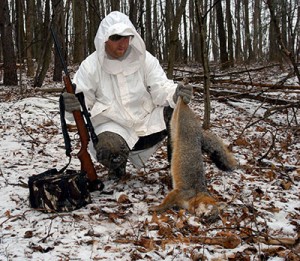 Use the terrain to hide you as much as possible, and always keep check of the wind. Yes it is far easier to use a field road, pipeline or trail to access an area, but you may be ruining your hunt before it ever gets started. Predators, especially coyotes, red fox and black bears, will always use the wind when coming to the call. They are on heightened alert as they approach. They hear something that interests them, but they have no idea what else they might run into. It may be another of their own species, or possibly something that may hurt them as well. Rarely will they come running recklessly to the call, which is why you must use the wind to your advantage, both while walking and when choosing your spot to set up.
Use the terrain to hide you as much as possible, and always keep check of the wind. Yes it is far easier to use a field road, pipeline or trail to access an area, but you may be ruining your hunt before it ever gets started. Predators, especially coyotes, red fox and black bears, will always use the wind when coming to the call. They are on heightened alert as they approach. They hear something that interests them, but they have no idea what else they might run into. It may be another of their own species, or possibly something that may hurt them as well. Rarely will they come running recklessly to the call, which is why you must use the wind to your advantage, both while walking and when choosing your spot to set up.
Changing conditions are another factor that many predator hunters fail to consider. The most common of these is when crops are picked, leaving the landscape barren. With the crops gone, many would-be prey species also move on, forcing the predators to look elsewhere for a meal. If you are hunting the same spots in the late season as you were during the early part of the season, chances are your success rate is much lower.
What about forest conditions? Snow can be a huge factor in where and when to hunt. The depth of the snow may force creatures like grey fox and raccoon to hole up for days before venturing out. It can also concentrate animals in a smaller area, especially in an evergreen thicket where the snow on the ground tends to be less than the surrounding countryside.
Leaves falling from the trees can open up areas that were too dense for sight earlier in the season. Those clearcuts and thicker areas that you passed up in November might just be the ideal places now. Not only does the thick cover hide the critters, it also serves as a windbreak during this colder time of the year. Predators normally do not have a huge fat reserve on them, so look for thickets that face to the south where they will hold up during the daylight hours.
Temperatures below freezing can create alternate traveling routes for the predators, as they can now use frozen streams, rivers and lakes as clear routes to access one place or another. They love to travel along the edges of the shorelines to hunt, which enables them to cover long distance but only be a few steps away from cover that they can hide in. Many hunters fail to realize that they may be driving past a potential hotspot when crossing frozen waters.
Predator hunting, just like any other type of hunting, requires constant attention to detail. I see far too many new hunters who simply buy a call, head to their local stomping grounds and expect animals to come running in. Some will learn their lessons the hard way. Others will simply give up after a few hunts and never enjoy the success that can be had through a little work. Put forth the effort and keep these key items in mind the next time you head out to hunt predators.

